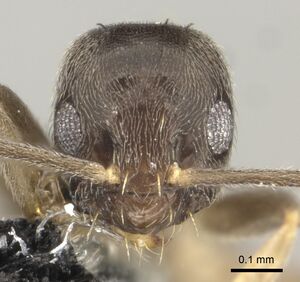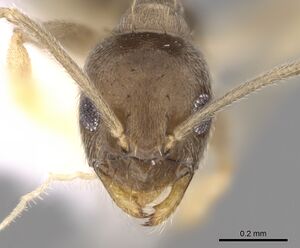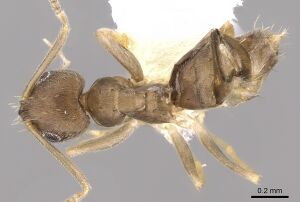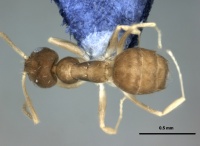Paraparatrechina oceanica
| Paraparatrechina oceanica | |
|---|---|

| |
| Scientific classification | |
| Kingdom: | Animalia |
| Phylum: | Arthropoda |
| Class: | Insecta |
| Order: | Hymenoptera |
| Family: | Formicidae |
| Subfamily: | Formicinae |
| Tribe: | Lasiini |
| Genus: | Paraparatrechina |
| Species: | P. oceanica |
| Binomial name | |
| Paraparatrechina oceanica (Mann, 1921) | |
Identification
Distribution
Latitudinal Distribution Pattern
Latitudinal Range: -16.51916695° to -19.11666679°.
| North Temperate |
North Subtropical |
Tropical | South Subtropical |
South Temperate |
- Source: AntMaps
Distribution based on Regional Taxon Lists
Indo-Australian Region: Fiji (type locality).
Distribution based on AntMaps
Distribution based on AntWeb specimens
Check data from AntWeb
Countries Occupied
| Number of countries occupied by this species based on AntWiki Regional Taxon Lists. In general, fewer countries occupied indicates a narrower range, while more countries indicates a more widespread species. |

|
Estimated Abundance
| Relative abundance based on number of AntMaps records per species (this species within the purple bar). Fewer records (to the left) indicates a less abundant/encountered species while more records (to the right) indicates more abundant/encountered species. |

|
Biology
Castes
Images from AntWeb
    
| |
| Not Provided. Worker. Specimen code casent0181303. Photographer Shannon Hartman, uploaded by California Academy of Sciences. | Owned by EPEC. |
   
| |
| Worker. Specimen code casent0281149. Photographer Cerise Chen, uploaded by California Academy of Sciences. | Owned by PSWC, Philip S. Ward Collection. |
Nomenclature
The following information is derived from Barry Bolton's Online Catalogue of the Ants of the World.
- oceanica. Prenolepis (Nylanderia) oceanica Mann, 1921: 476 (w.) FIJI IS. Combination in Paratrechina (Nylanderia): Emery, 1925b: 221; in Paraparatrechina: LaPolla, Brady & Shattuck, 2010a: 128. Given as junior synonym of minutula by Dlussky, 1994: 55 (in list only); status confirmed as species: Sarnat & Economo, 2012: 67.
Description
References
- Emery, C. 1925d. Hymenoptera. Fam. Formicidae. Subfam. Formicinae. Genera Insectorum 183: 1-302 (page 221, Combination in Paratechina (Nylanderia))
- Mann, W. M. 1921. The ants of the Fiji Islands. Bulletin of the Museum of Comparative Zoology 64: 401-499 (page 476, worker described)
- Sarnat, E.M. & Economo, E.P. 2012. The ants of Fiji: 384 pp. UC Publications in Entomology, University of California Press.
References based on Global Ant Biodiversity Informatics
- CSIRO Collection
- Mann W. M. 1921. The ants of the Fiji Islands. Bulletin of the Museum of Comparative Zoology 64: 401-499.
- Sarnat Eli M. 2009. The Ants [Hymenoptera: Formicdiae] of Fiji: Systematics, Biogeography and Conservation of an Island Arc Fauna. 80-252
- Ward, Darren F. and James K. Wetterer. 2006. Checklist of the Ants of Fiji. Fiji Arthropods III 85: 23-47.
- Wheeler W.M. 1935. Check list of the ants of Oceania. Occasional Papers of the Bernice Pauahi Bishop Museum 11(11):1-56.
- Wheeler, William Morton.1935.Checklist of the Ants of Oceania.Occasional Papers 11(11): 3-56
- Wilson E.O., and G.L. Hunt. 1967. Ant fauna of Futuna and Wallis islands, stepping stones to Polynesia. Pacific Insects 9(4): 563-584.
- Wilson, Edward O. and George L. Hunt. 1967. Ant Fauna of Futuna and Wallis Islands, Stepping Stones To Polynesia. Pacific Insects. 9(4):563-584.
- Wilson, Edward O. and Hunt, George L. Jr. 1967. Ant Fauna of Futuna and Wallis Islands, Stepping Stones to Polynesia. Pacific Insects. 9(4):563-584

